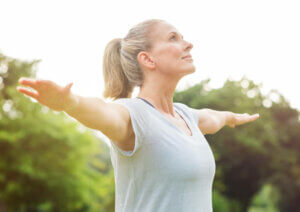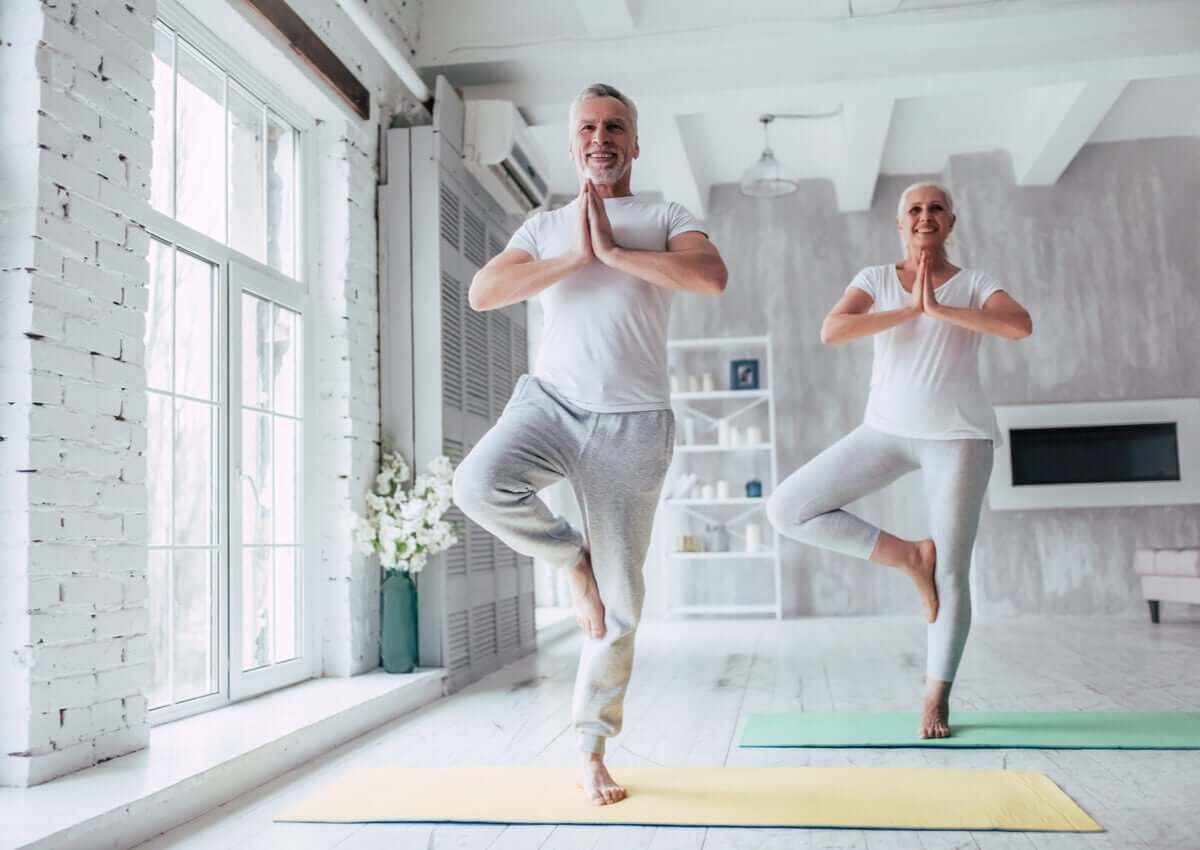4 Helpful Balance Exercises for Seniors

Older people are in their last vital stage and, contrary to what many people think, they must remain active, vigorous, and healthy. With that in mind, it may be advisable to perform various balance exercises to adequately maintain this capacity.
During all stages of life, including older adulthood, people should work to enhance and maintain their physical capabilities. In the following article, we’ll emphasize balance, one of the most necessary abilities from the age of 60 onwards.
Why is balance so important?
Balance is one of the physical capacities of the human being. We use it at all times of life and, like most skills, we need to work on it, improve it, and try to maintain it.
However, during older adulthood, this ability becomes more relevant due to muscle, bone, and joint deterioration. This increases the probability of falls, one of the most relevant problems at this stage of life.
Therefore, older people should perform static and dynamic balance exercises. Of course, they must take place within the context of training routines that adapt to the individual’s physical and psychological capabilities.

Balance exercises
If you’re an elderly person or you take care of one, we recommend you take into account the exercise recommendations that we’ll reveal. These should be part of a weekly routine and, of course, performed under the supervision of a professional. This is crucial in order to avoid any injury or major problems.
Common gait training exercises
Gait training isn’t only an exercise to strengthen dynamic balance in the elderly, but it also works to diagnose how the person is doing. For obvious reasons, it’s not a professional diagnosis, but it does help to determine the state of this ability and what deficiencies the person has. It’s done in the following way:
- Draw a straight line on a stable surface.
- Perform 20 normal steps (as the person normally walks).
- The person can also do 20 steps forward and 20 steps back, depending on the individual’s condition.
Balance exercises: static lifting
Static balance is just as important as dynamic balance. The first exercise to stimulate this ability is doing leg lifts while staying in the same place. The steps are as follows:
- Find a surface suitable for supporting the hands. It can be a chair or other similar element, but it shouldn’t be higher than the person who’ll perform the exercise.
- Stand in front of the back of the chair and rest both hands on it.
- Raise your right leg and hold the position for approximately 10 seconds. When performing the exercise, it’s advisable to rest only the hand opposite to the leg being lifted.
Lateral displacements

In addition to stimulating dynamic balance, lateral displacements can also contribute to the strengthening of muscles that aren’t often used as much, such as the abductors. The technique is as follows:
- Draw a straight line on the floor to have as a reference.
- Perform the lateral displacements by raising the leg as high as possible. Do this first with one limb and then with the other.
- Carry out at least 20 steps with each leg.
Balance exercises: static gait
The static walking exercise consists of simulating walking without moving forward. This serves to stimulate the muscles of the legs and the core zone; in addition, it can be applied to people with little mobility.
- Get a comfortable chair in which the back is straight and the feet can be fully supported.
- Rest the hands on the thighs or on the sides, depending on the comfort of each person.
- Raise the legs alternately. Here you should simulate walking and raise each limb in a harmonious manner.
- Perform at least 20 steps, 10 with each leg.
Balance exercises and what to keep in mind
There are many balance exercises that can be included in a routine. The choice depends very much on the individual’s ability and the creativity of the elderly person’s caregiver. As a World Health Organization publication states, there are more and more elderly people in the world.
However, you should note that this type of exercise shouldn’t be performed every day. Both joints and muscles require rest and recovery. At the same time, joint activation and a corresponding muscle warm-up are essential before each session. This is something you can never overlook!
Older people are in their last vital stage and, contrary to what many people think, they must remain active, vigorous, and healthy. With that in mind, it may be advisable to perform various balance exercises to adequately maintain this capacity.
During all stages of life, including older adulthood, people should work to enhance and maintain their physical capabilities. In the following article, we’ll emphasize balance, one of the most necessary abilities from the age of 60 onwards.
Why is balance so important?
Balance is one of the physical capacities of the human being. We use it at all times of life and, like most skills, we need to work on it, improve it, and try to maintain it.
However, during older adulthood, this ability becomes more relevant due to muscle, bone, and joint deterioration. This increases the probability of falls, one of the most relevant problems at this stage of life.
Therefore, older people should perform static and dynamic balance exercises. Of course, they must take place within the context of training routines that adapt to the individual’s physical and psychological capabilities.

Balance exercises
If you’re an elderly person or you take care of one, we recommend you take into account the exercise recommendations that we’ll reveal. These should be part of a weekly routine and, of course, performed under the supervision of a professional. This is crucial in order to avoid any injury or major problems.
Common gait training exercises
Gait training isn’t only an exercise to strengthen dynamic balance in the elderly, but it also works to diagnose how the person is doing. For obvious reasons, it’s not a professional diagnosis, but it does help to determine the state of this ability and what deficiencies the person has. It’s done in the following way:
- Draw a straight line on a stable surface.
- Perform 20 normal steps (as the person normally walks).
- The person can also do 20 steps forward and 20 steps back, depending on the individual’s condition.
Balance exercises: static lifting
Static balance is just as important as dynamic balance. The first exercise to stimulate this ability is doing leg lifts while staying in the same place. The steps are as follows:
- Find a surface suitable for supporting the hands. It can be a chair or other similar element, but it shouldn’t be higher than the person who’ll perform the exercise.
- Stand in front of the back of the chair and rest both hands on it.
- Raise your right leg and hold the position for approximately 10 seconds. When performing the exercise, it’s advisable to rest only the hand opposite to the leg being lifted.
Lateral displacements

In addition to stimulating dynamic balance, lateral displacements can also contribute to the strengthening of muscles that aren’t often used as much, such as the abductors. The technique is as follows:
- Draw a straight line on the floor to have as a reference.
- Perform the lateral displacements by raising the leg as high as possible. Do this first with one limb and then with the other.
- Carry out at least 20 steps with each leg.
Balance exercises: static gait
The static walking exercise consists of simulating walking without moving forward. This serves to stimulate the muscles of the legs and the core zone; in addition, it can be applied to people with little mobility.
- Get a comfortable chair in which the back is straight and the feet can be fully supported.
- Rest the hands on the thighs or on the sides, depending on the comfort of each person.
- Raise the legs alternately. Here you should simulate walking and raise each limb in a harmonious manner.
- Perform at least 20 steps, 10 with each leg.
Balance exercises and what to keep in mind
There are many balance exercises that can be included in a routine. The choice depends very much on the individual’s ability and the creativity of the elderly person’s caregiver. As a World Health Organization publication states, there are more and more elderly people in the world.
However, you should note that this type of exercise shouldn’t be performed every day. Both joints and muscles require rest and recovery. At the same time, joint activation and a corresponding muscle warm-up are essential before each session. This is something you can never overlook!
All cited sources were thoroughly reviewed by our team to ensure their quality, reliability, currency, and validity. The bibliography of this article was considered reliable and of academic or scientific accuracy.
- Ganoza, M. (2009). El adulto mayor. Revista De Adulto Mayor.
- Saüch, G., Castañer Balcells, M., & Hileno González, R. (2013). Valorar la capacidad de equilibrio en la tercera edad. Retos: Nuevas Tendencias En Educación Física, Deporte y Recreación.
This text is provided for informational purposes only and does not replace consultation with a professional. If in doubt, consult your specialist.








